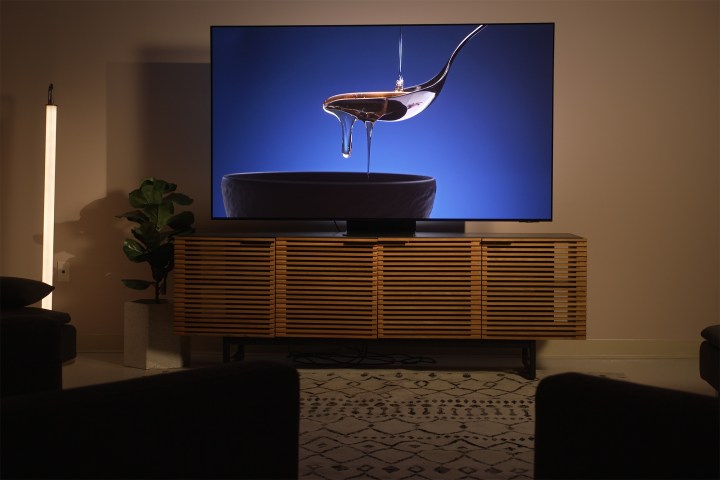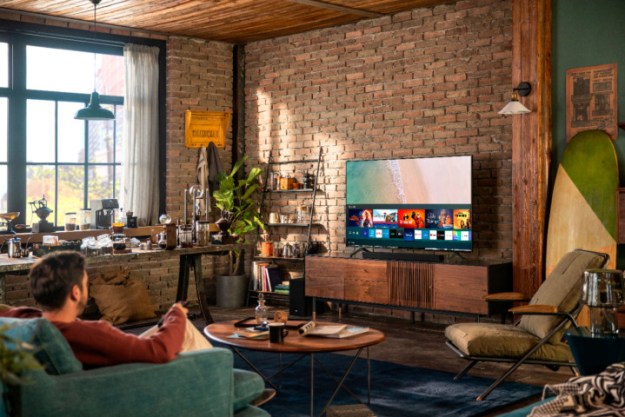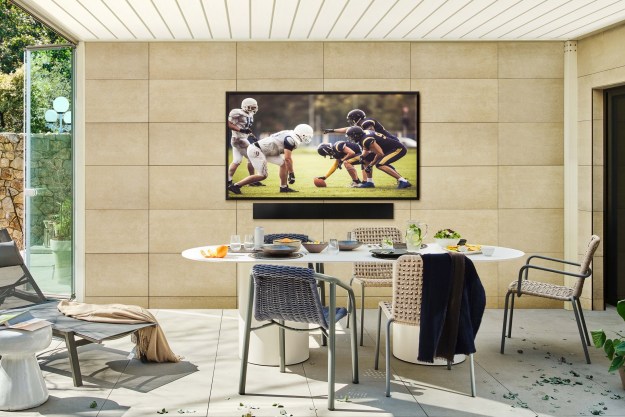What could be worth traveling 3,000 miles in a cramped airplane to New Jersey? The chance to go hands-on with not one, but three of Samsung’s most hotly anticipated TVs for 2023.
I got up close and personal with the 65-inch QN95C Neo QLED, the 75-inch QN900C 8K Neo QLED, and the 77-inch S95C QD-OLED. I had Samsung representatives on hand to address questions as I had them, and I got the opportunity to make some comparisons among the TVs that I don’t often get a chance to do so soon after the TVs have been announced.
When I first arrived, I wondered if Samsung’s surprisingly strong QN95C 4K Neo QLED might actually steal some of the highly anticipated 77-inch S95C QD-OLED’s thunder. You see, I started by checking out the 8K QN900C, then progressed to the 4K QN95C — both are QLED TVs. The latter was so impressive, I had to wonder if the premium that came along with the new QD-OLED tech was going to be justified. But then I turned on the 77-inch S95C, and all wonder was washed away.
The Samsung S95C is one of the most gorgeous TVs I’ve laid eyes on, and it is easily in the running to be the best TV of 2023.
Even with the impressive upscaling on display with the 8K QN900C and the utterly astonishing brightness and black levels of the QN95C, the S95C QD-OLED still won my heart that day. And a big part of that was because I was so happy to see that QD-OLED performance in a 77-inch model — that really did a lot for me. I know a lot of people have been curious about whether the 77-inch size would make all that much of a difference – and it really does.
Brightness: reality vs. perception
Let’s back up and do a quick reminder for folks who may not have tuned in for this year’s CES. We learned that the second generation of Samsung’s QD-OLED technology is more efficient and has higher peak brightness – both in terms of white brightness, and pure red, green, and blue primary color brightness.
That means that the display panel itself could potentially hit up to 2,000 nits of brightness — that’s a very exciting number. But that’s what the panel can do. As we learned from last year, that doesn’t mean that Samsung Electronics — the arm of Samsung that takes the panel and makes it into a TV — is necessarily going to unlock all of that brightness potential.
So there’s been some concern that maybe Samsung would cap the peak brightness a bit. Samsung Display says the panel can peak at 2100 nits, but Samsung might want to rein the TV in a bit, either to increase its operating life span by not driving the blue OLED pixels at full blast or because Samsung feels being more selective about when the TV reaches peak brightness leads to a better user experience.
After measuring 1,600 nits with various test patterns, I think it is clear the TV’s potential brightness has been limited to some degree. During real-world viewing, it’s possible that Samsung’s processor could apply higher brightness sparingly, like a quick glint of reflected sunlight. I think we should hold out final judgment until we can test this TV with real content and see what the TV does with peak highlights for short bursts on-screen. But it does appear that Samsung isn’t just shooting for the moon when it comes to brightness. And that might be for the best.
The contrast ratio is just off the charts.
Fixating on peak white brightness gets in the way of understanding how this TV’s perceived brightness is going to play out. Because the color brightness is just unprecedented on OLED, and that includes last year’s QD-OLEDs.
After this trip, I no longer worry about QD-OLED’s viability in bright rooms. Can it get as bright as the QN95C Neo QLED? No, it can’t. But when you consider you’re talking about pure blacks on the S95C, the contrast ratio is just off the charts. And keep in mind that the measurements I took were in the TV’s filmmaker mode, with color temperature set to the warmer side. With a cooler color temperature (akin to the daylight light bulbs you might use in your home, with more of the blue light wavelengths involved), the perceived brightness of the S95C would be even higher.
At any rate, I watched the S95C in a fully lit room with 18 fluorescent tubes glaring down and I was plenty dazzled by the perceived brightness of this television.
More first impressions
Now, on the not-as-glowing side, the TV’s out-of-box white point measurements weren’t great. Red and blue measured very hot in the brightest whites, and needed some taming down to get the white point accurate — strange, since the efficiency of the green quantum is meant to be quite good. Perhaps there was some overcompensating at play?
Setting that aside, the S95C’s out-of-box color accuracy was superb, and color volume was the best I measured all day: 74% of BT.2020 and 100% of Rec. 709. In TV geek speak, that’s spectacular.
Just watching TV for about 15 minutes was a treat, too. No red flags in terms of motion resolution, upscaling, or shadow detail.

Again, I’ll want to spend more time with the TV, but all signs point to this being in contention with one, maybe two other TVs for the best TV of 2023.
While I think it is fun to make some educated guesses about how these TVs are going to do this year, I also think it is important to remember that firmware updates can and will happen. I won’t be comfortable definitively ranking TVs and pitting them against each other until at least one month in, and six weeks is probably a better waiting period. As Samsung deploys firmware updates to its TVs, their performance capabilities will change, for better or worse.
Don’t rush to judgment
Enjoy the excitement. Samsung earned it. But do remember that what you hear about these TVs through most of March are early impressions, subject to change. This year, perhaps more than any other in the past, it’s going to be prudent to see how things shake out after the TVs have been in the wild and any firmware updates that get deployed have been ironed out. If we learned nothing else from 2022 TVs, it’s that waiting a few weeks to indulge our inner early adopter is a smart move.
With that said, I think Samsung has some serious momentum going into 2023. Now that I’ve gotten to sit with these TVs for a while, get some early measurements, and just enjoy watching them, there’s no doubt in my mind the QN95C and the S95C are going to be huge contenders for best TV awards this year.
Editors' Recommendations
- Best Walmart TV deals: 43-inch 4K TV for $195 and more
- Best OLED TV deals: Save on LG C3, Samsung S90C, and more
- Best 75-inch TV deals: Get a big screen from $500
- Samsung unveils pricing and preorder details for its 2024 OLED TVs
- Best Samsung TV deals: Save on 4K TVs, QLED TVs, OLED TVs, 8K TVs








